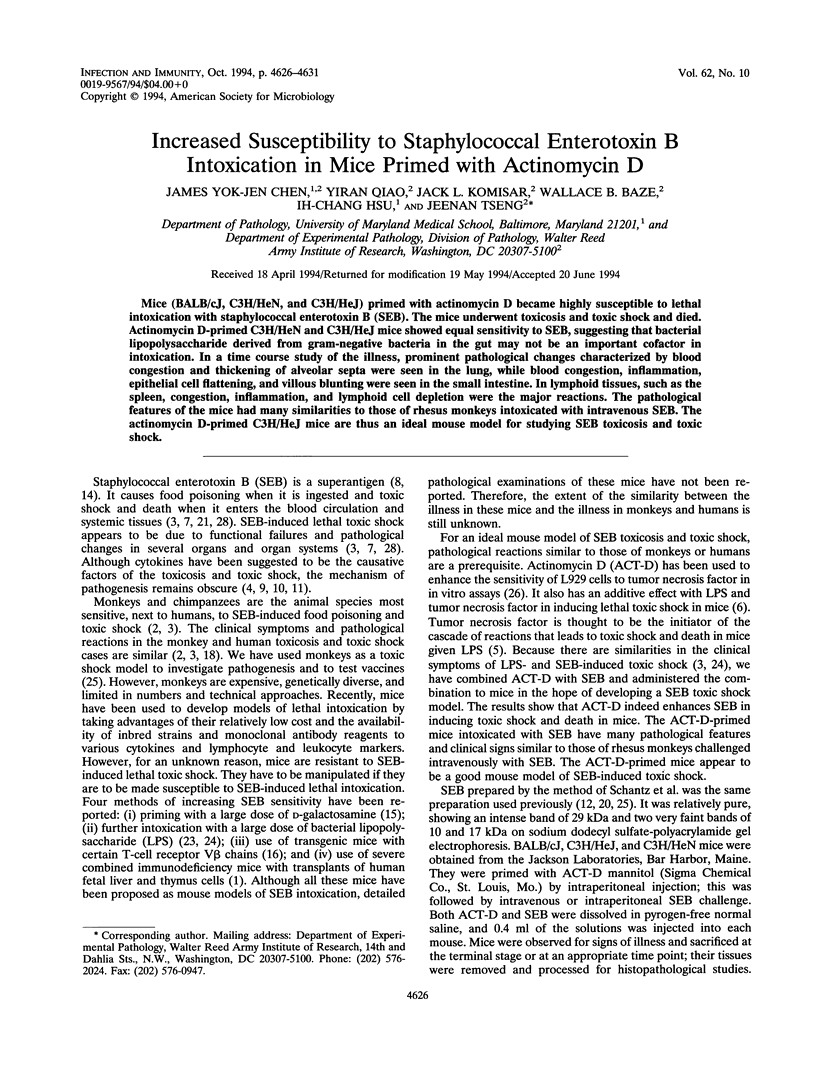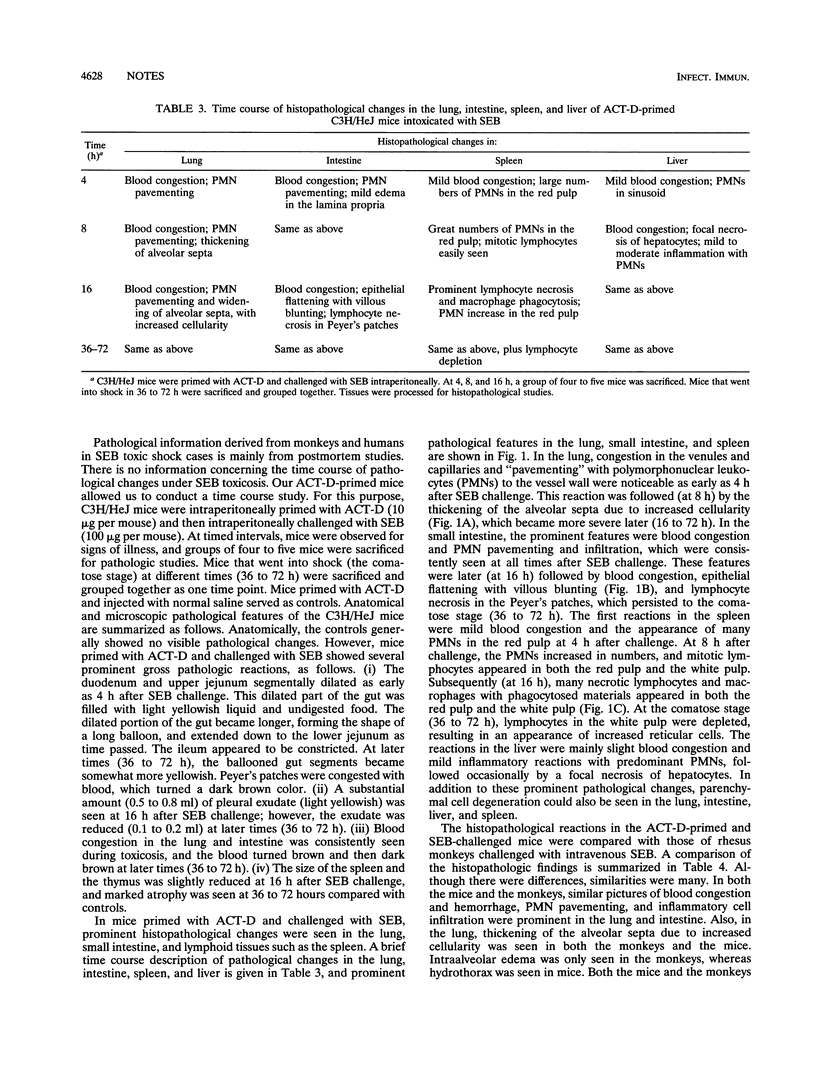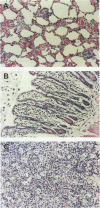Abstract
Mice (BALB/cJ, C3H/HeN, and C3H/HeJ) primed with actinomycin D became highly susceptible to lethal intoxication with staphylococcal enterotoxin B (SEB). The mice underwent toxicosis and toxic shock and died. Actinomycin D-primed C3H/HeN and C3H/HeJ mice showed equal sensitivity to SEB, suggesting that bacterial lipopolysaccharide derived from gram-negative bacteria in the gut may not be an important cofactor in intoxication. In a time course study of the illness, prominent pathological changes characterized by blood congestion and thickening of alveolar septa were seen in the lung, while blood congestion, inflammation, epithelial cell flattening, and villous blunting were seen in the small intestine. In lymphoid tissues, such as the spleen, congestion, inflammation, and lymphoid cell depletion were the major reactions. The pathological features of the mice had many similarities to those of rhesus monkeys intoxicated with intravenous SEB. The actinomycin D-primed C3H/HeJ mice are thus an ideal mouse model for studying SEB toxicosis and toxic shock.
Full text
PDF





Images in this article
Selected References
These references are in PubMed. This may not be the complete list of references from this article.
- Baccala R., Vandekerckhove B. A., Jones D., Kono D. H., Roncarolo M. G., Theofilopoulos A. N. Bacterial superantigens mediate T cell deletions in the mouse severe combined immunodeficiency-human liver/thymus model. J Exp Med. 1993 May 1;177(5):1481–1485. doi: 10.1084/jem.177.5.1481. [DOI] [PMC free article] [PubMed] [Google Scholar]
- Beisel W. R. Pathophysiology of staphylococcal enterotoxin, type B, (SEB) toxemia after intravenous administration to monkeys. Toxicon. 1972 Aug;10(5):433–440. doi: 10.1016/0041-0101(72)90167-5. [DOI] [PubMed] [Google Scholar]
- Bette M., Schäfer M. K., van Rooijen N., Weihe E., Fleischer B. Distribution and kinetics of superantigen-induced cytokine gene expression in mouse spleen. J Exp Med. 1993 Nov 1;178(5):1531–1539. doi: 10.1084/jem.178.5.1531. [DOI] [PMC free article] [PubMed] [Google Scholar]
- Beutler B., Cerami A. The biology of cachectin/TNF--a primary mediator of the host response. Annu Rev Immunol. 1989;7:625–655. doi: 10.1146/annurev.iy.07.040189.003205. [DOI] [PubMed] [Google Scholar]
- Buckley N. J., Walther P. J., Das A. K., Poulton S. H. Schedule-dependent enhanced lethality with combined administration of actinomycin D and tumor necrosis factor in mice. J Biol Response Mod. 1989 Jun;8(3):287–296. [PubMed] [Google Scholar]
- Choi Y. W., Kotzin B., Herron L., Callahan J., Marrack P., Kappler J. Interaction of Staphylococcus aureus toxin "superantigens" with human T cells. Proc Natl Acad Sci U S A. 1989 Nov;86(22):8941–8945. doi: 10.1073/pnas.86.22.8941. [DOI] [PMC free article] [PubMed] [Google Scholar]
- Fast D. J., Schlievert P. M., Nelson R. D. Toxic shock syndrome-associated staphylococcal and streptococcal pyrogenic toxins are potent inducers of tumor necrosis factor production. Infect Immun. 1989 Jan;57(1):291–294. doi: 10.1128/iai.57.1.291-294.1989. [DOI] [PMC free article] [PubMed] [Google Scholar]
- Johnson H. M., Russell J. K., Pontzer C. H. Staphylococcal enterotoxin microbial superantigens. FASEB J. 1991 Sep;5(12):2706–2712. doi: 10.1096/fasebj.5.12.1916093. [DOI] [PubMed] [Google Scholar]
- Kappler J., Kotzin B., Herron L., Gelfand E. W., Bigler R. D., Boylston A., Carrel S., Posnett D. N., Choi Y., Marrack P. V beta-specific stimulation of human T cells by staphylococcal toxins. Science. 1989 May 19;244(4906):811–813. doi: 10.1126/science.2524876. [DOI] [PubMed] [Google Scholar]
- Komisar J., Rivera J., Vega A., Tseng J. Effects of staphylococcal enterotoxin B on rodent mast cells. Infect Immun. 1992 Jul;60(7):2969–2975. doi: 10.1128/iai.60.7.2969-2975.1992. [DOI] [PMC free article] [PubMed] [Google Scholar]
- Marrack P., Blackman M., Kushnir E., Kappler J. The toxicity of staphylococcal enterotoxin B in mice is mediated by T cells. J Exp Med. 1990 Feb 1;171(2):455–464. doi: 10.1084/jem.171.2.455. [DOI] [PMC free article] [PubMed] [Google Scholar]
- Marrack P., Kappler J. The staphylococcal enterotoxins and their relatives. Science. 1990 May 11;248(4956):705–711. doi: 10.1126/science.2185544. [DOI] [PubMed] [Google Scholar]
- Miethke T., Wahl C., Heeg K., Echtenacher B., Krammer P. H., Wagner H. T cell-mediated lethal shock triggered in mice by the superantigen staphylococcal enterotoxin B: critical role of tumor necrosis factor. J Exp Med. 1992 Jan 1;175(1):91–98. doi: 10.1084/jem.175.1.91. [DOI] [PMC free article] [PubMed] [Google Scholar]
- Perkins D. L., Wang Y., Ho S. S., Wiens G. R., Seidman J. G., Rimm I. J. Superantigen-induced peripheral tolerance inhibits T cell responses to immunogenic peptides in TCR (beta-chain) transgenic mice. J Immunol. 1993 May 15;150(10):4284–4291. [PubMed] [Google Scholar]
- Pettit G. W., Elwell M. R., Jahrling P. B. Possible endotoxemia in rabbits after intravenous injection of Staphylococcus aureus enterotoxin B. J Infect Dis. 1977 Apr;135(4):646–648. doi: 10.1093/infdis/135.4.646. [DOI] [PubMed] [Google Scholar]
- Raj H. D., Bergdoll M. S. Effect of enterotoxin B on human volunteers. J Bacteriol. 1969 May;98(2):833–834. doi: 10.1128/jb.98.2.833-834.1969. [DOI] [PMC free article] [PubMed] [Google Scholar]
- Rosenstreich D. L., Glode L. M. Difference in B cell mitogen responsiveness between closely related strains of mice. J Immunol. 1975 Sep;115(3):777–780. [PubMed] [Google Scholar]
- Schantz E. J., Roessler W. G., Wagman J., Spero L., Dunnery D. A., Bergdoll M. S. Purification of staphylococcal enterotoxin B. Biochemistry. 1965 Jun;4(6):1011–1016. doi: 10.1021/bi00882a005. [DOI] [PubMed] [Google Scholar]
- Schlievert P. M. Staphylococcal enterotoxin B and toxic-shock syndrome toxin-1 are significantly associated with non-menstrual TSS. Lancet. 1986 May 17;1(8490):1149–1150. doi: 10.1016/s0140-6736(86)91859-3. [DOI] [PubMed] [Google Scholar]
- Stiles B. G., Bavari S., Krakauer T., Ulrich R. G. Toxicity of staphylococcal enterotoxins potentiated by lipopolysaccharide: major histocompatibility complex class II molecule dependency and cytokine release. Infect Immun. 1993 Dec;61(12):5333–5338. doi: 10.1128/iai.61.12.5333-5338.1993. [DOI] [PMC free article] [PubMed] [Google Scholar]
- Sugiyama H. Endotoxin-like responses induced by staphylococcal enterotoxin. J Infect Dis. 1966 Apr;116(2):162–170. doi: 10.1093/infdis/116.2.162. [DOI] [PubMed] [Google Scholar]
- Tseng J., Komisar J. L., Chen J. Y., Hunt R. E., Johnson A. J., Pitt L., Rivera J., Ruble D. L., Trout R., Vega A. Immunity and responses of circulating leukocytes and lymphocytes in monkeys to aerosolized staphylococcal enterotoxin B. Infect Immun. 1993 Feb;61(2):391–398. doi: 10.1128/iai.61.2.391-398.1993. [DOI] [PMC free article] [PubMed] [Google Scholar]
- Voitenok N. N., Misuno N. I., Panyutich A. V., Kolesnikova T. S. Induction of tumor necrosis factor synthesis in human monocytes treated by transcriptional inhibitors. Immunol Lett. 1989 Jan 15;20(1):77–82. doi: 10.1016/0165-2478(89)90072-2. [DOI] [PubMed] [Google Scholar]
- Watson J., Kelly K., Largen M., Taylor B. A. The genetic mapping of a defective LPS response gene in C3H/HeJ mice. J Immunol. 1978 Feb;120(2):422–424. [PubMed] [Google Scholar]
- Wright S. W., Trott A. T. Toxic shock syndrome: a review. Ann Emerg Med. 1988 Mar;17(3):268–273. doi: 10.1016/s0196-0644(88)80121-5. [DOI] [PubMed] [Google Scholar]



